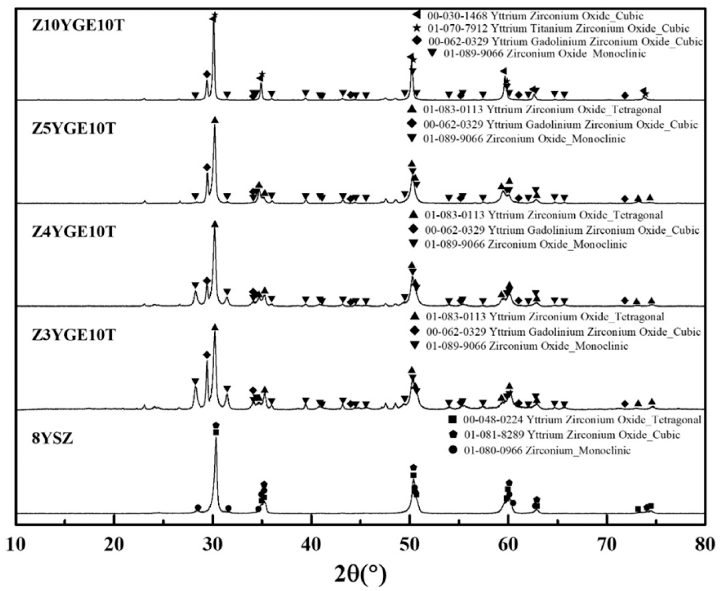Search
- Page Path
- HOME > Search
- [Korean]
- Formation of Phases and Mechanical Properties of YSZ-Based Thermal Barrier Coating Materials Doped with Rare Earth Oxides
- Yong Seok Choi, Gye Won Lee, Sahn Nahm, Yoon suk Oh
- J Powder Mater. 2023;30(5):402-408. Published online October 1, 2023
- DOI: https://doi.org/10.4150/KPMI.2023.30.5.402

- 1,061 View
- 13 Download
-
 Abstract
Abstract
 PDF
PDF This study focused on improving the phase stability and mechanical properties of yttria-stabilized zirconia (YSZ), commonly utilized in gas turbine engine thermal barrier coatings, by incorporating Gd2O3, Er2O3, and TiO2. The addition of 3-valent rare earth elements to YSZ can reduce thermal conductivity and enhance phase stability while adding the 4-valent element TiO2 can improve phase stability and mechanical properties. Sintered specimens were prepared with hot-press equipment. Phase analysis was conducted with X-ray diffraction (XRD), and mechanical properties were assessed with Vickers hardness equipment. The research results revealed that, except for Z10YGE10T, most compositions predominantly exhibited the t-phase. Increasing the content of 3-valent rare earth oxides resulted in a decrease in the monoclinic phase and an increase in the tetragonal phase. In addition, the t(400) angle decreased while the t(004) angle increased. The addition of 10 mol% of 3-valent rare-earth oxides discarded the t-phase and led to the complete development of the c-phase. Adding 10 mol% TiO2 increased hardness than YSZ.
- [Korean]
- Analysis of Monoclinic Phase Change and Microstructure According to High-temperature Heat Treatment of Oxide-doped YSZ
- Gye-Won Lee, Yong-Seok Choi, Chang-Woo Jeon, In-Hwan Lee, Yoon-Suk Oh
- J Powder Mater. 2022;29(6):468-476. Published online December 1, 2022
- DOI: https://doi.org/10.4150/KPMI.2022.29.6.468

- 919 View
- 6 Download
-
 Abstract
Abstract
 PDF
PDF Yttria-stabilized zirconia (YSZ) has a low thermal conductivity, high thermal expansion coefficient, and excellent mechanical properties; thus, it is used as a thermal barrier coating material for gas turbines. However, during long-time exposure of YSZ to temperatures of 1200°C or higher, a phase transformation accompanied by a volume change occurs, causing the YSZ coating layer to peel off. To solve this problem, YSZ has been doped with trivalent and tetravalent oxides to obtain coating materials with low thermal conductivity and suppressed phase transformation of zirconia. In this study, YSZ is doped with trivalent oxides, Nd2O3, Yb2O3, Al2O3, and tetravalent oxide, TiO2, and the thermal conductivity of the obtained materials is analyzed according to the composition; furthermore, the relative density change, microstructure change, and m-phase formation behavior are analyzed during long-time heat treatment at high temperatures.
TOP
 kpmi
kpmi

 First
First Prev
Prev


